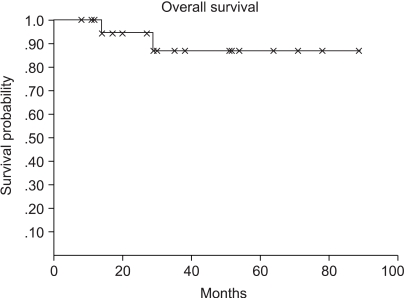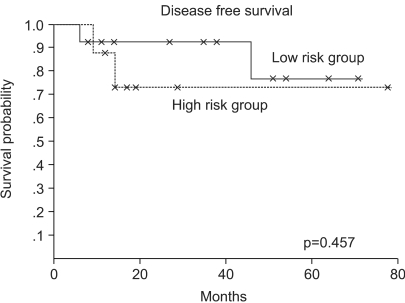Cancer Res Treat.
2005 Feb;37(1):31-36.
Treatment Outcome of Limited Stage Hodgkin's Disease
- Affiliations
-
- 1Division of Hematology-Oncology, Department of Medicine, Samsung Medical Center, Sungkyunkwan University School of Medicine, Seoul, Korea. newatp@naver.com
- 2Radiation Oncology, Samsung Medical Center, Sungkyunkwan University School of Medicine, Seoul, Korea.
Abstract
- PURPOSE
The 10-year overall survival rate following conventional treatments for patients with limited-stage Hodgkin's disease (HD) exceeds 90%. However, the clinical features and treatment outcome of HD in Korea have not been extensively characterized due to its low incidence. In this study, we attempted to analyze the treatment outcome of different modalities in limited stage HD patients. MATERIALS AND METHODS: Twenty one Hodgkin's disease patients, referred to the Samsung Medical Center between January 1997 and December 2003, were enrolled in this study. Limited stage Hodgkin's disease was subdivided into low and high risk groups. All evaluable patients received treatment. RESULTS: There were 13 and 8 patients in the low and high risk groups, respectively. Eighteen patients (86%) obtained complete response (CR) and 3 patients (14%) achieved an undetermined complete response (CRu). Fourteen (67%), 4 (19%) and 3 (14%) cases received combination chemotherapy, radiotherapy alone and chemotherapy alone, respectively. Four cases relapsed and 2 obtained a second CR. The 5-year overall and disease- free survival rates were 90 and 72%, respectively, for all patients. The median follow-up duration was 31 months. There was no difference in disease free survival (DFS) between the low and high risk groups. Although 12 cases had neutropenia greater than grade III, none experienced neutropenic fever. CONCLUSION: The treatment outcome of limited-stage HD was excellent, regardless to the initial treatment modality.
Keyword
MeSH Terms
Figure
Reference
-
1. Rosenberg SA, Kaplan HS. The evolution and summary results of the Stanford randomized clinical trials of the management of Hodgkin's disease: 1962-1984. Int J Radiat Oncol Biol Phys. 1985; 11:5–22. PMID: 3881376.
Article2. Kaplan HS. The radical radiotherapy of regionally localized Hodgkin's disease. Radiology. 1962; 78:553–561. PMID: 14453744.
Article3. Devita VT Jr, Serpick AA, Carbone PP. Combination chemotherapy in the treatment of advanced Hodgkin's disease. Ann Intern Med. 1970; 73:881–895. PMID: 5525541.4. Harding MJ, McNulty LJ, Paul J, Lee F, Brown A, Soukop M. Mechlorethamine, vinblastine, procarbazine and prednisolone (MVPP) for advanced Hodgkin's disease. Eur J Cancer. 1991; 27:1002–1006. PMID: 1832882.
Article5. Hancock BW, Vaughan Hudson G, Vaughan Hudson B, Haybittle JL, Bennett MH, MacLennan KA, et al. British national lymphoma investigation randomised study of MOPP (mustine, Oncovin, procarbazine, prednisolone) against LOPP (Leukeran substituted for mustine) in advanced Hodgkin's disease--long term results. Br J Cancer. 1991; 63:579–582. PMID: 2021542.6. Bonadonna G, Zucali R, Monfardini S, De Lena M, Uslenghi C. Combination chemotherapy of Hodgkin's disease with adriamycin, bleomycin, vinblastine, and imidazole carboxamide versus MOPP. Cancer. 1975; 36:252–259. PMID: 54209.
Article7. Miller TP, Dahlberg S, Cassady JR, Adelstein DJ, Spier CM, Grogan TM, et al. Chemotherapy alone compared with chemotherapy plus radiotherapy for localized intermediate- and highgrade non-Hodgkin's lymphoma. N Engl J Med. 1998; 339:21–26. PMID: 9647875.
Article8. Lister TA, Crowther D, Sutcliffe SB, Glatstein E, Canellos GP, Young RC, et al. Report of a committee convened to discuss the evaluation and staging of patients with Hodgkin's disease: Cotswolds meeting. J Clin Oncol. 1989; 7:1630–1636. PMID: 2809679.
Article9. Lee JM, Hwang KS, Choi GW, Kang DY. Malignant lymphoma in Korea. Korean J Hematol. 1977; 12:1–20.10. Kim KW, Chang YB, Kim MC, Son CH. Clinical observation on 55 cases of Hodgkin's disease. Korean J Hematol. 1982; 17:35–44.11. Park YH, Suh CO, Kim GE, Loh JK. Radiotherapy in Hodgkin's disease. J Korean Cancer Assoc. 1992; 24:277–287.12. Connors JM, Noordijk EM, Horning SJ. Hodgkin's lymphoma: basing the treatment on the evidence. Hematology (Am Soc Hematol Educ Program). 2001; 178–193. PMID: 11722984.
Article13. Cimino G, Biti GP, Anselmo AP, Maurizi Enrici R, Bellesi GP, Bosi A, et al. MOPP chemotherapy versus extended-field radiotherapy in the management of pathological stages I-IIA Hodgkin's disease. J Clin Oncol. 1989; 7:732–737. PMID: 2715803.
Article14. Sieber M, Franklin J, Tesch H. Two cycles ABVD plus extended field radiotherapy is superior to radiotherapy alone in early stage Hodgkin's disease:Results of the German Hodgkin's Lymphoma Study Group(GHSG) Trial HD7. Blood. 2002; 100:A341.15. Press OW, LeBlanc M, Lichter AS, Grogan TM, Unger JM, Wasserman TH, et al. Phase III randomized intergroup trial of subtotal lymphoid irradiation versus doxorubicin, vinblastine, and subtotal lymphoid irradiation for stage IA to IIA Hodgkin's disease. J Clin Oncol. 2001; 19:4238–4244. PMID: 11709567.
Article16. Laskar S, Gupta T, Vimal S, Muckaden MA, Saikia TK, Pai SK, et al. Consolidation radiation after complete remission in Hodgkin's disease following six cycles of doxorubicin, bleomycin, vinblastine, and dacarbazine chemotherapy: is there a need? J Clin Oncol. 2004; 22:62–68. PMID: 14657226.
Article17. Bonfante V, Viviani S, Devizz I. 10-year experience with AVBD plus radiotherapy; subtotal nodal (STNI) versus involved-field (IFRT) in early-stage Hodgkin's disease. Proc Am Soc Clin Oncol. 2001; 20:281a.18. Engert A, Schiller P, Josting A, Herrmann R, Koch P, Sieber M, et al. Involved-field radiotherapy is equally effective and less toxic compared with extended-field radiotherapy after four cycles of chemotherapy in patients with early-stage unfavorable Hodgkin's lymphoma: results of the HD8 trial of the German Hodgkin's Lymphoma Study Group. J Clin Oncol. 2003; 21:3601–3608. PMID: 12913100.
Article19. Ferme C, Eghbali H, Hagenbeek A, Brice P, Meder J, Carde P, et al. MOPPABV hybrid and irradiation in unfavorable supradiaphragmatic clinical stages I-II Hodgkins disease: Comparison of three treatment modalities. Preliminary results of the EORTC-GELA H8-U randomized trial in 995 patients. Blood. 2000; 96:A576.20. Diehl V, Stein H, Hummel M, Zollinger R, Connors JM. Hodgkin's lymphoma: biology and treatment strategies for primary, refractory, and relapsed disease. Hematology (Am Soc Hematol Educ Program). 2003; 225–247. PMID: 14633784.
Article21. Multani PS, Grossbard ML. Staging laparotomy in the management of Hodgkin's disease: Is It Still Necessary? Oncologist. 1996; 1:41–55. PMID: 10387968.
Article
- Full Text Links
- Actions
-
Cited
- CITED
-
- Close
- Share
- Similar articles
-
- Treatment in Patients with Early-Stage Hodgkin's Lymphoma
- Retrospective Analysis of Treatment Outcome and Prognostic Factors in Hodgkin's Disease
- A case of non-Hodgkin's lymphoma developed after radiotherapy in Hodgkin's disease
- Treatment Outcome and Prognostic Factors for Children with Advanced Non-Hodgkin's Lymphoma at a Single Institution
- The Result of Combined Modality Treatment for Non-Hodgkin's Lymphoma of Head and Neck



